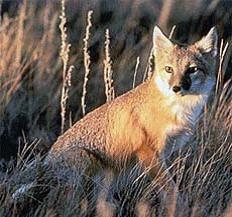Once nearly extinct, the swift fox is making a comeback!
Species upgraded to ‘threatened’ After three decades of difficult work by Canadian scientists – including hundreds of cold winter nights spent capturing swift foxes in live traps baited with butcher scraps and bacon – the small, speedy bushytailed animals are no longer an endangered species.
While the swift fox was all but extinct in Canada in 1978, recent live-trapping population surveys show that reintroduction efforts have successfully re-established swift fox populations in Alberta and Saskatchewan.
As a result, the federal government downlisted the status of the species to threatened from endangered.
“In most situations because of greater and greater impacts on the world around us, the status of many species is getting worse,” said Axel Moehrenschlager, head of the Centre for Conservation Research at the Calgary Zoo and co-chair the Canadian Swift Fox Recovery Team. “When we are successful in making the status of the species better, that’s both unusual, actually, and something that really needs to be celebrated.
“Recent population surveys show there are more than 600 swift foxes in the Canadian wild and Moehrenschlager called the successful reintroduction of the animals – one of only two carnivores in Canada that has gone extinct – “incredibly rare.”
“It’s one of the most successful carnivore reintroduction programs in the world,” Moehrenschlager said. Changing the status of a species in Canada is a process that involves an assessment by the Committee on the Status of Endangered Wildlife in Canada (COSEWIC), a recommendation by COSEWIC to the federal government and a decision on whether to accept the assessment by the federal environment minister.
In June, Environment Minister Peter Kent signed off on the improved swift fox status, said Pat Fargey, a species at-risk biologist with Parks Canada.”It certainly is remarkable to have a species extirpated from Canada, reintroduced and then to be downlisted to endangered and then, of course, to threatened just recently,” Fargey said.
While a “threatened” label is still worrying and means there is work to be done to ensure the survival of the species and protection of its habitat, the improved status is a major achievement, said Moehrenschlager, who has spent much of his career studying the creatures.
The swift fox, (Vulpesvelox), is the smallest of the North Americanfoxes. The full grown animal is only about the size of a domesticcat. Aptly named for its ability to run at speeds of over 50km/h, the swift fox is also known as the “kit” or “prairie” fox.
“Swift foxes, over 20 years ago, captured my imagination and admiration just because they’re such a charismatic, little, beautiful animal that was so in need of help that it inspired me to dedicate a lot of my career to that cause,” he said. “There are few things in my job that make me happier than to see a swift fox in the wild.”Once abundant throughout the Prairies, the last sighting of a swift fox in the Canadian wild was in 1938.The fur trade, combined with habitat loss caused by agricultural development and extensive wildlife poisoning programs that took place as the Prairies were settled, are blamed for the disappearance of the animal, which is of great cultural significance to First Nations people.
During the 1980s, captive breeding programs were established and the reintroduction of both captive-bred and translocated swift foxes into the Canadian wild began.
Source: Calgary Herald Website

